By PAM SMITH
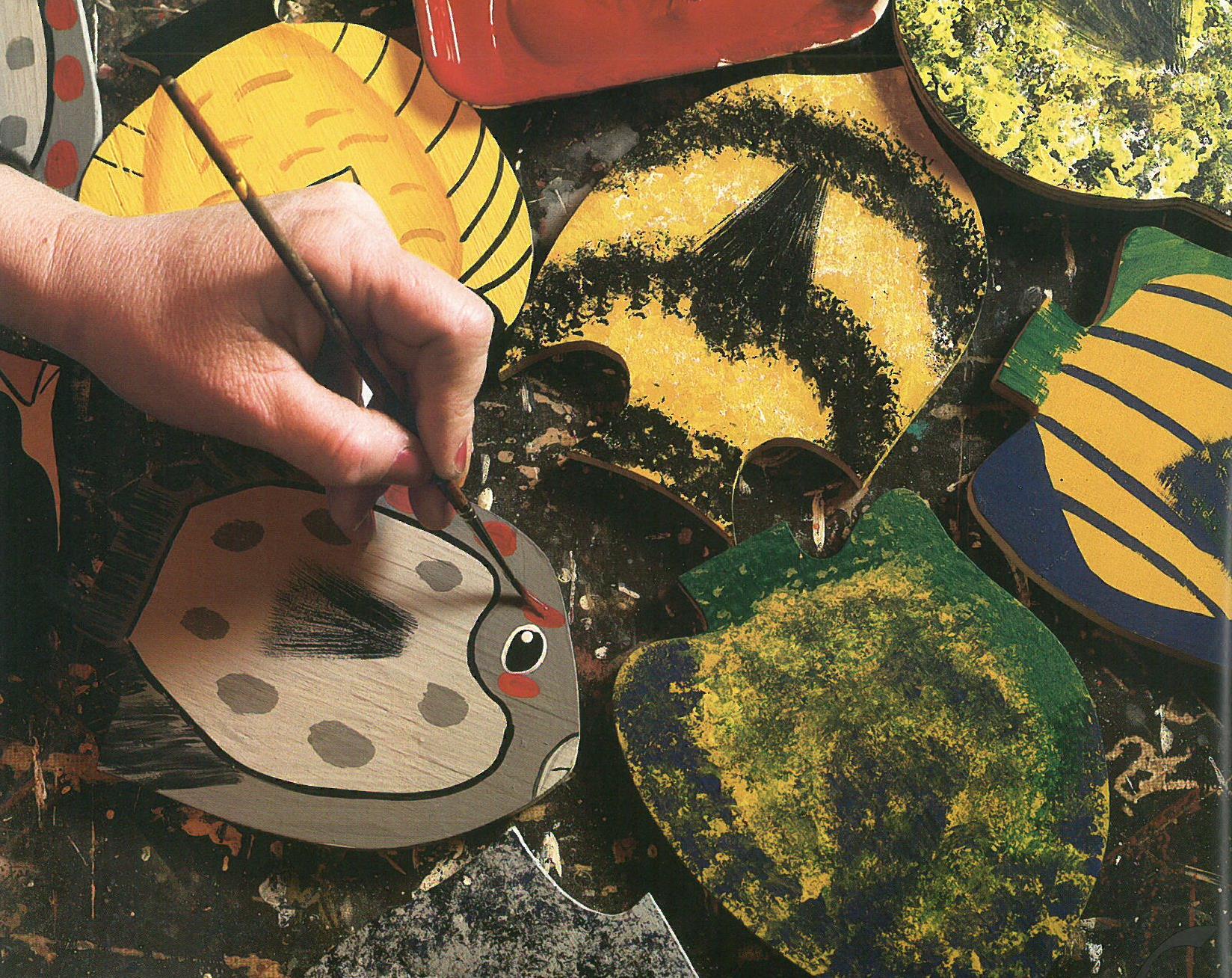
The rich coastal culture is reflected in many craft forms, such as these colorful painted fish ornaments. Photo courtesy of Watermark Association of Artisans.
A colorful quilt provides a backdrop for what could be a corner of Santa’s workshop.
Rag dolls sit in painted wagons waiting for just the right child to come along and take them on a merry ride. Stuffed monkeys climb the shelves. And, an old-fashioned bed doll with a very haughty look seems impatient for the holiday party to begin.
The quilt, it turns out, is much more than a decorative prop. It’s a history — each square is a chapter noting the contribution individual artisans have made to the Watermark Association of Artisans since its 1978 founding.
And the collection of dolls, children’s furniture and wooden toys are part of an adventure that could begin another successful chapter in the story of the 500-member craft cooperative. Hundreds of Watermark folk crafts are being featured for the holiday season in a shop at the trendy Georgetown Park Mall in Washington, D.C.
But we’re getting ahead of ourselves.
Watermark, located on U.S. 158 East in Camden, began with about 25 charter members. It quickly gained national attention for its high-quality Carolina crafts — and its mission to provide meaningful income for artisans in the sparsely populated, rural northeastern region of the state.
Early on, forward-thinking Watermark members began to cultivate national wholesale markets that could provide volume sales for its shareholder members. Soon, the QVC shoppers’ channel offered Watermark merchandise, and Ralph Lauren contracted for special products. Watermark hand-painted buttons — each unique — were featured on Esprit clothing.
Today, about 5,000 lucky little girls are clutching Watermark’s Sara doll, which was produced exclusively for Smithsonian Institution shops.
But, wait a minute. How can home-made, hand-crafted items be both one-of-a-kind and produced in volume?
It’s easy to explain when you know the history. Watermark artisans could provide all the human capital and creative energy needed to produce unique merchandise. But the members realized the need for hard cash. So, the Northeast Education Economic Development Foundation (NEED) was established to bring in grant dollars that could be used to train the members in a range of craft skills to ensure product quality.
Say a QVC contract called for Watermark hand-painted stools. NEED grants would underwrite the cost of the necessary raw materials as well as training workshops for a cadre of Watermark artisans needed to produce the quantity and quality.
From the start, NEED training looked to help the women develop craft skills, business skills and personal skills — ingredients for self-sufficiency. A child-care facility also was established to provide a safe environment during the training sessions.
NEED has since evolved to become the Northeastern Community Development Center (NCDC). The center still provides training workshops for Watermark artisans. Its child-care facility has expanded and serves all the community.
LEARNING SELF-ESTEEM
For many long-time Watermark members, the training program has made a world of difference in their lives.
Take Jocelyn House, whose painted glass iced tea set is pictured on the front cover of Panache, an international mail order catalogue. Her glassware, with a painted grape cluster motif, also was the featured item in Gevalia coffee’s spring catalogue.
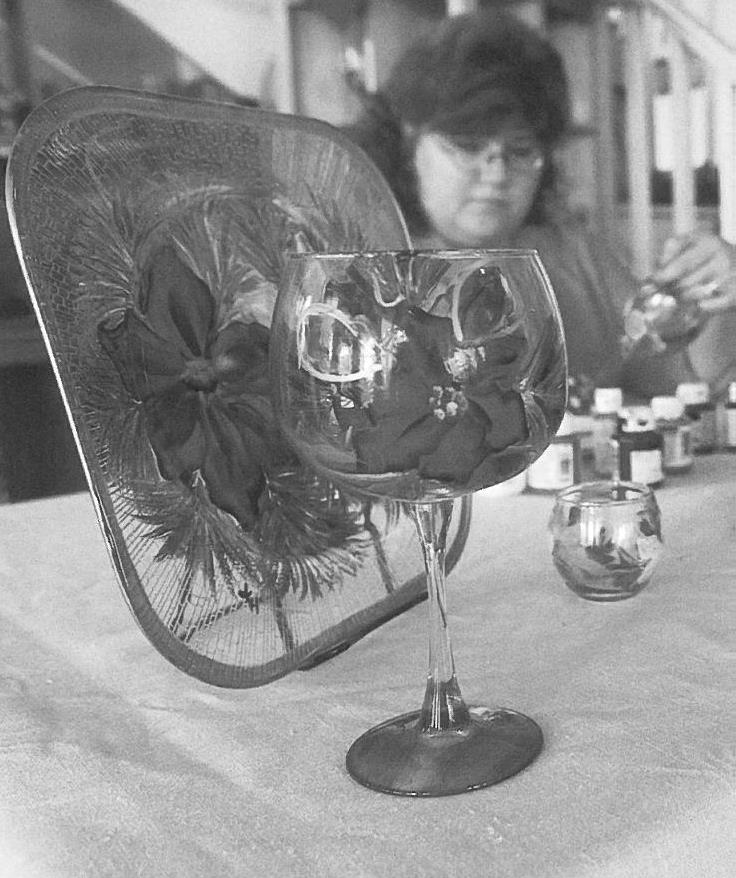
Jocelyn House puts finishing touches on hand-painted glass items featured in national mail order catalogues. Photo by Michael Halminski.
Never in her wildest dreams did she think that could happen. That is, never in her pre-Watermark dreams. The co-op provided the opportunity to hone her artistic skills and gain the self-confidence needed to market her products and herself. Now, House trains other artisans in the fine points of glass painting and design. “It’s a way to give back,” she says.
House also has become competent in other crafts to help fill large, special project contracts.
That might mean helping with production of traditional rag dolls — the love of Beverly Cupery’s life. The dolls come in various sizes and with different hair colors, including powder blue, pink and orange.
It was Cupery’s Sara doll that passed Smithsonian’s rigorous muster. “Sara came with four different skin colors, so she had a lot of international appeal,” she says. “It took about six months to produce enough to fill the contract.”
She is proud to have helped give Watermark that kind of public exposure. But she is just as proud to be part of an outreach effort closer to home. Cupery and House regularly team up to bring arts and crafts to special needs children in the Elizabeth City and Camden schools.
“We enjoy sharing our gifts with others,” she says. “And the kids just open up.”
Diane Poole, too, is a long-time Watermark member. She learned a number of handcrafts growing up in the Camden area. “But I always wanted to learn to carve,” she confesses.
So, when Watermark offered a wood carving class, she was first in line.
“It’s something I think I must have in me. My father, grandfather, great and probably great-greatgrandfather were boat builders. My dad told me stories of my grandfather, Alvery Wright, who built shad boats and carved decoys. He died when I was an infant, and I felt like I could connect with him if I could just learn to carve,” Poole explains.
One of her grandfather’s shad boats is on display at the Museum of the Albemarle in Elizabeth City. And, long after his death, one of his decoys brought a tidy $25,000 at a decoy festival.
Poole’s love for birds, especially local songbirds, is reflected in her wood carvings. She says she talks to them as she coaxes them out of wood blocks, carving, then painting lifelike details.
Watermark has given her confidence to try new things, she says. She has designed, and taught others to produce, lap desks for the Georgetown Park Mall project. And another creative idea is taking form — painting on bird feathers she collects, and then mounting them in a shadowbox. She is toying with the idea of using natural bark material for the matting.
Her husband, Al, also is a Watermark member. Together, they create and paint children’s and doll’s furniture also on display in Georgetown.
BRANCHING OUT
Dee Sprouse, who has been Watermark’s executive director for less than a year, is leading a reorganization of the co-op. She will provide her marketing and fund-raising expertise.
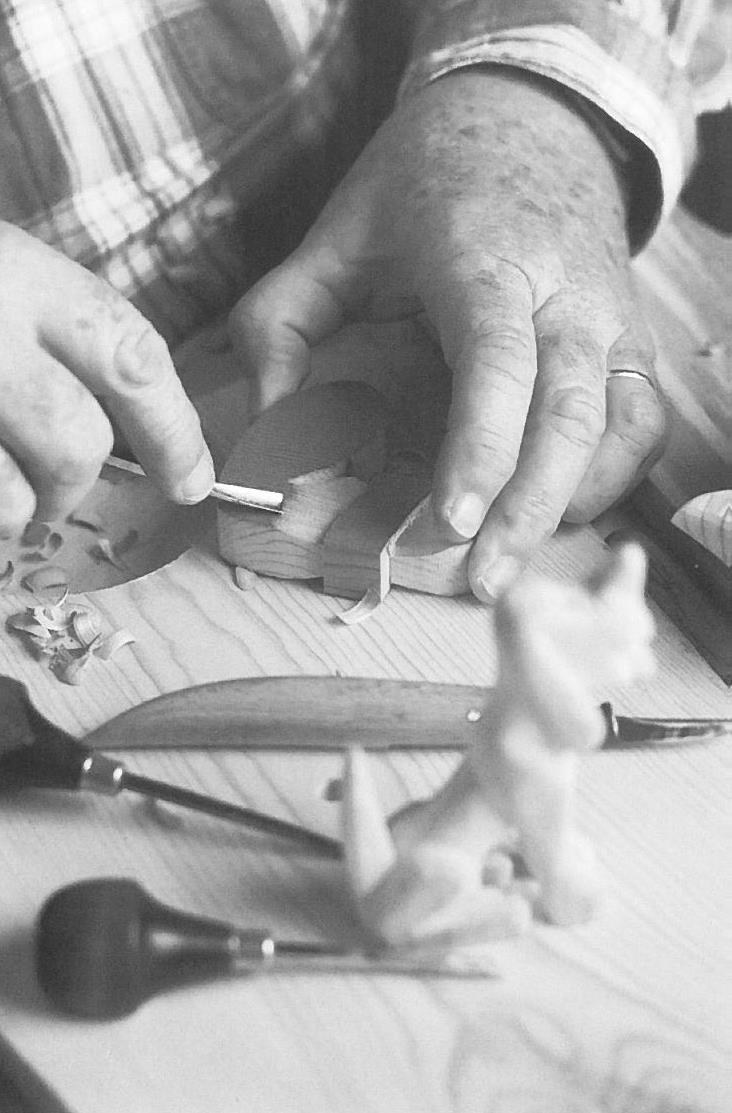
Willie Jimerson, a retired carpenter, began carving as a youngster looking to earn extra pocket money. Photo courtesy Watermark Association of Artisans.
In her office, Sprouse flips through scrapbooks that are filled with newspaper and magazine articles telling of Watermark’s milestones. Videotapes contain snippets of television feature stories on Watermark. Even Gloria Steinem visited Watermark to support the co-op’s economic development work. And, Watermark was honored at the 1994 Women’s World Conference for promoting economic justice.
Watermark is a model craft cooperative, Sprouse says. “Watermark has helped local women find independence. And, we have provided training for women from many countries through grants from USAID.”
Women from several African and Latin American countries have traveled to Watermark to complete the training program in order to replicate the co-op model in their villages.
There is a lot to be proud of, Sprouse reflects, closing the scrapbook. She takes a small, framed picture from her desk.
“This is the federal angel, an ornament selected to adorn the Christmas tree in the White House Blue Room in 1993,” Sprouse says. The ornament, made by Watermark crafter Katherine Wassink, holds a miniature basket by another member, Marie Hewitt.
“We have evolved, and are still evolving,” Sprouse notes. “We are building on the strength of our own history.”
At one time, nearly all the members were women. In recent years, more men have joined the co-op.
Willie Jimerson is one. The retired carpenter used to specialize in restoring woodwork in old homes. Now, he produces one of the most sought after Watermark holiday items — an abstract wood-carved nativity set.
Jimerson began carving as a youngster, making and selling key chain trinkets to earn movie money. His first Watermark product was a Santa on skis.
“I branched out after that proved to be a success,” he recalls. His repertoire includes a number of collectible carved items and a cheerful hound dog just for fun.
Watermark, too, is branching out with some new product lines to meet consumer wants, Sprouse says. “You could say we’re evolving now to meet new global market expectations.”
That will not mean any compromise in quality. “Watermark products always will stand out as professional, high quality and polished,” Sprouse says.
She sees Watermark’s strength in the combined energy and talent — and sometimes connections — of its members.
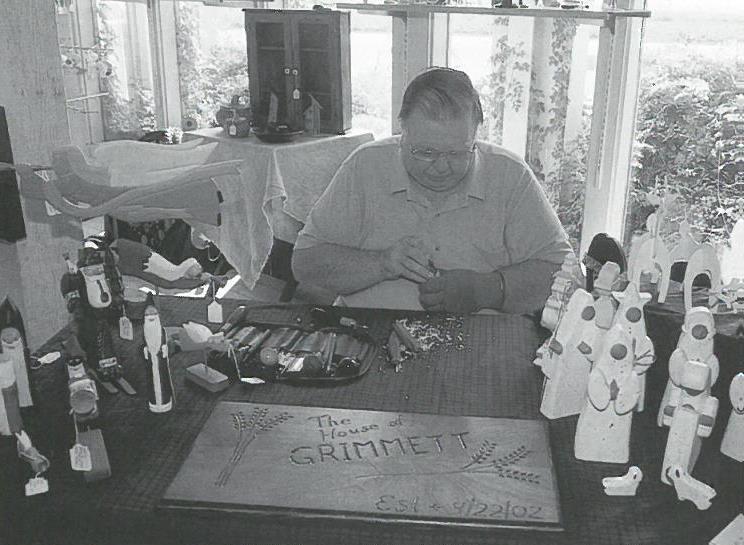
Jimerson is surrounded by some of Watermark’s most sought-after holiday items. Photo by Michael Halminski.
The Georgetown Park Mall retail opportunity, for example, came about because a Watermark member knows the leasing agent. “We are excited about this temporary tenant arrangement. We’re open to a longer arrangement if we are successful with holiday sales,” Sprouse says.
Meanwhile, Sprouse has engaged 16 sales representatives to present Watermark products to a number of new wholesale outlets. And a major distributor has agreed to represent Watermark at important craft shows in Atlanta and Philadelphia. What’s more, Watermark continues to be featured in national mail order catalogues.
Expanding wholesale markets, Sprouse says, will bring greater income to Watermark artisans.
Board member Karen Peterson is coordinating a new training initiative for members. “Training continues to be an important part of Watermark’s mission,” Peterson says. “It’s the only way to have the number of artisans needed to get product volume to a critical mass for special projects.”
Quality training turns self-taught crafters into polished artisans, she adds.
Branching out will not mean abandoning traditional Carolina crafts. “There is a rich craft tradition here,” Sprouse says. “So much of the area culture is reflected in our products.”
Water themes. Boat themes. Shorebird themes. Baskets made with sedge and pine needles. Candles with decorative sea shells. Quilts.
That won’t change, Sprouse says. “We will find ways to develop new crafts that follow emerging trends.”
While she keeps the business side of Watermark going, she continues to help members in big and small ways.
“Transportation is a problem in rural areas,” she says. So, Sprouse personally helps get members to training sessions, delivers supplies, picks up finished products — and delivers members’ well-earned paychecks.
Their earnings are based on just how much time they put into the endeavor. For those who consider Watermark a full-time job, the sky is the limit. Others supplement their “day jobs” by producing crafts at home on a part-time basis.
HUMAN CAPITAL
Jack Thigpen, North Carolina Sea Grant’s extension director and coastal community extension specialist, believes that Watermark will continue to make a positive impact on the northeast region of the state.
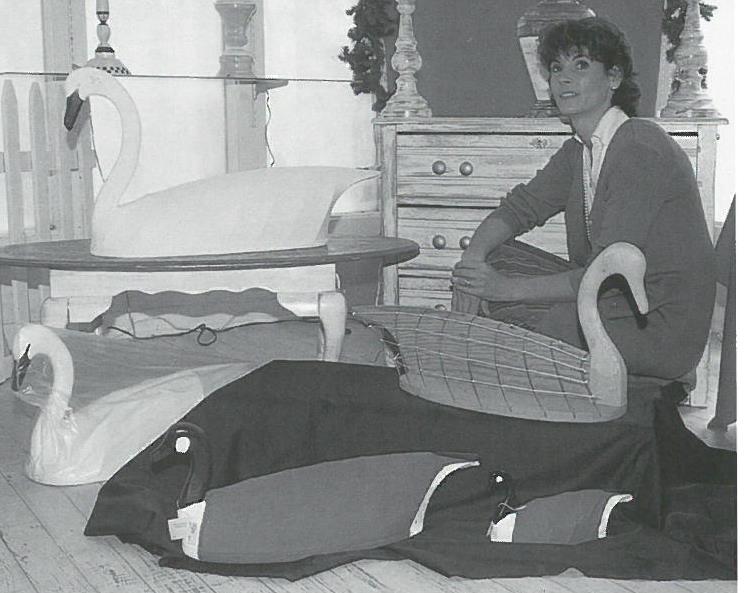
Dee Sprouse, now at the helm of Watermark, says a lot of heart goes into every Watermark product, such as these traditional decoys. Photo by Michael Halminski.
While many North Carolina coastal communities are experiencing phenomenal growth, Camden is one of more than a dozen counties in this sector of the coastal plain considered “economically distressed” by the N.C. Department of Commerce.
“According to the Department of Commerce, the per capita income and average wage in these rural counties are about 20 percent below the statewide levels, and unemployment is above state averages,” Thigpen points out.
In addition, this region, which has 5 percent of the North Carolina population, is not expected to keep up with projected population growth for the rest of the state in the next decade.
“By creating opportunities for local residents to earn money and develop their skills, Watermark is increasing the human and community capital that will make a difference in the long run,” Thigpen says.
Sprouse will continue to work with the NCDC to secure grants to help train new members and “cross train” others. Watermark is one of the essential employers in Camden and neighboring counties, with about 500 members and another 40-plus on the membership waiting list.
“We want to be the top community co-op,” Sprouse says. “Working together, we can accomplish anything. Watermark has always been known as the co-op that cares. Watermark helps members develop self-esteem and self-awareness. And members help members grow.”
She adds, “I know the future is bright for Watermark. A lot of talent and a lot of heart goes into all of our products. That hasn’t changed and won’t change.”
So there it is. The colorful Watermark memory quilt truly is a symbol of the collective talent that has shaped its history — so far.
The Watermark Association of Artisans is located at 150 U.S.158 East in Camden. For information, call 252/338-0853. Or go online to www.watermarkusa.com.
This article was published in the Holiday 2002 issue of Coastwatch.
For contact information and reprint requests, visit ncseagrant.ncsu.edu/coastwatch/contact/.
